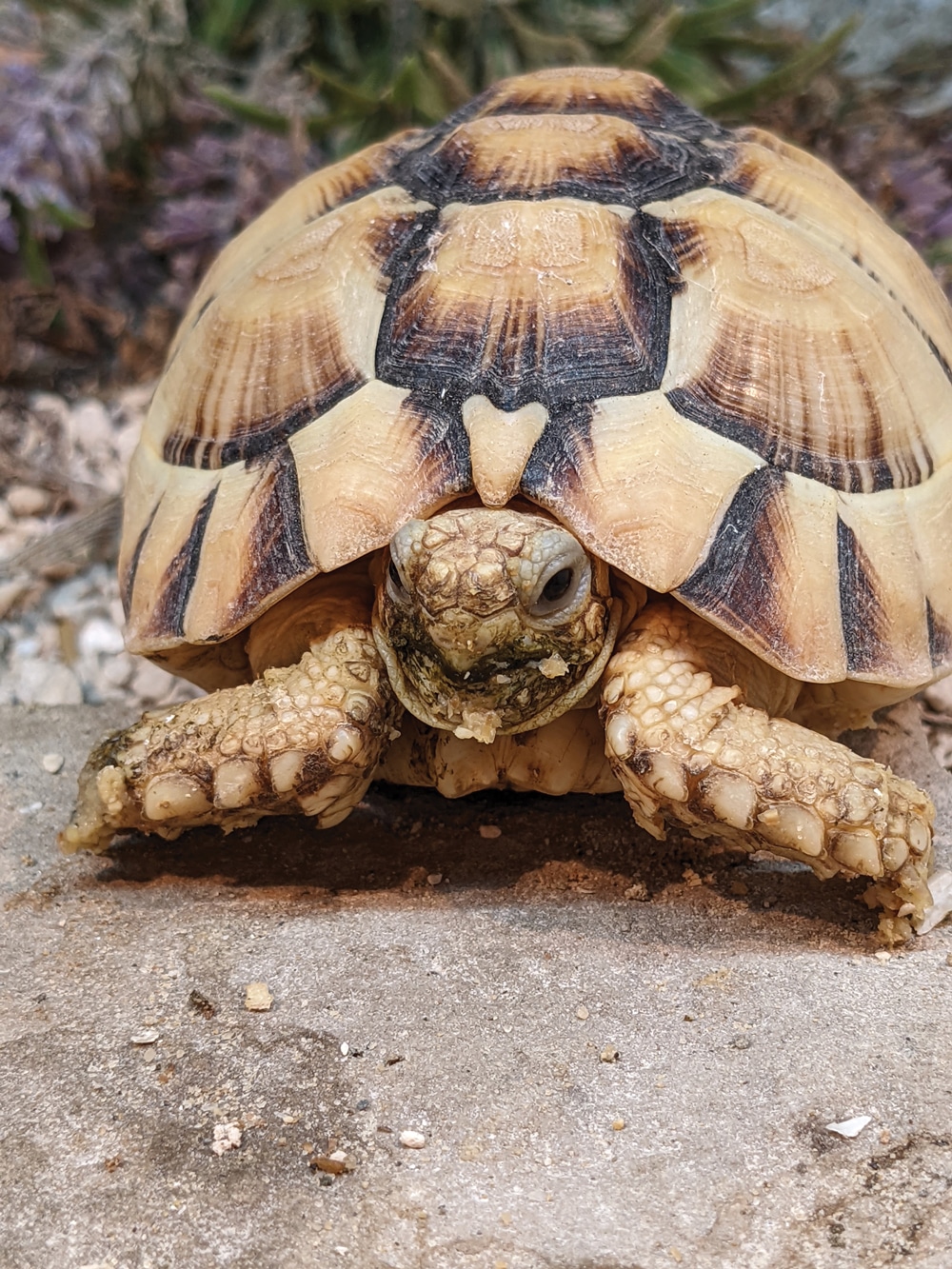The Egyptian tortoise, Testudo kleinmanni, has been a fan-favorite for reptile keepers in the United States for many years.
The Egyptian tortoise, Testudo kleinmanni, has been a fan-favorite for reptile keepers in the United States for many years, due to its small size, pretty appearance, and high activity levels. While the species has been kept and bred in captivity for decades now, they are no longer imported, legally or otherwise, and captive keepers have begun making great strides in producing and preserving the species. Despite this, a new petition aims to list the species on the federal Endangered Species Act (ESA) which would limit the ability for this to continue as it has.
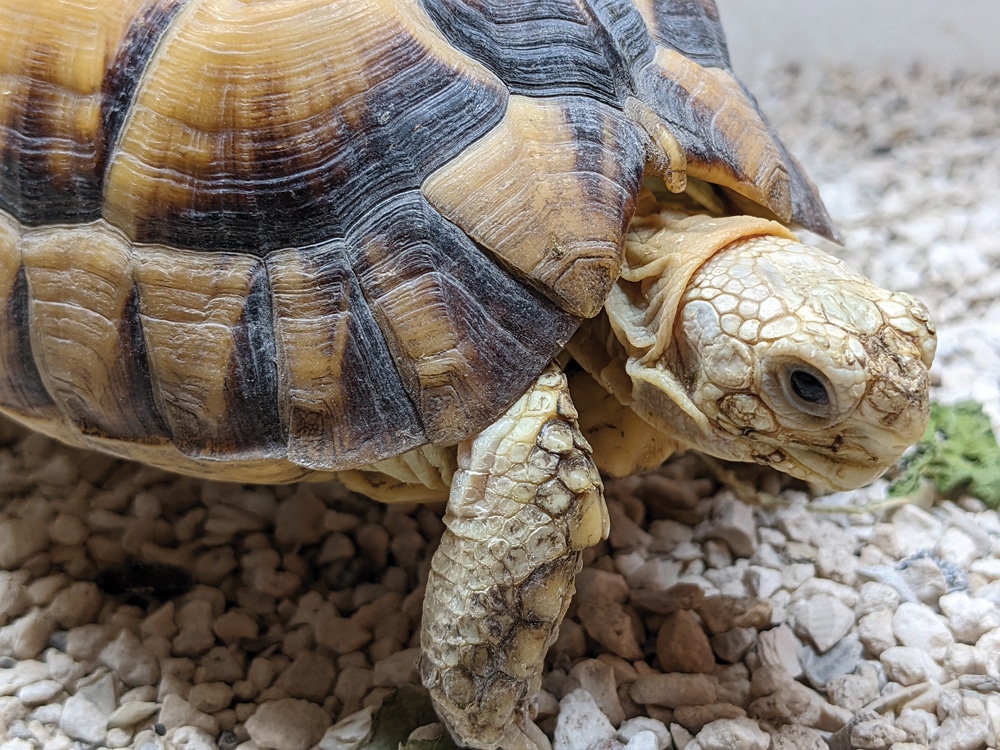
Egyptian tortoises seem to prefer temperatures between about 75 to 80 degrees Fahrenheit (23.9 to 26.7 degrees Celsius).
Unfortunately for the Egyptian tortoise, unchecked and poorly managed regulations in its native range of Libya, Egypt and Israel have left this diminutive species on the brink of extinction. Habitat destruction has claimed over 95 percent of their original territory, with the remaining 5 percent in peril. In 1995 these countries all joined the Convention on International Trade in Endangered Species (CITES), which aims to regulate international trade in endangered species, but this is rarely enforced and is relatively ineffective today. It is a harsh reality, but laws are only as good as the countries that enforce them.
A listing on the ESA would mean that the species could no longer be sold or traded across state lines. Several turtle and tortoise species are currently listed on the ESA, and for native species from the United States, it makes sense to list animals, as wild animals are often affected by interstate trade during poaching and illegal sales. Listing a species also makes prosecution of smugglers and poachers easier and more aggressive. For non-natives, however, particularly species that are not being imported at all, even illegally, the listing makes no sense and is of no benefit to the species or law enforcement.
Captive Care
The Egyptian tortoise has a very high metabolism and the species therefore displays a higher need for more food and more frequent (i.e. daily) feedings than one might expect. The amount of food these tortoises eat and seem to need to remain healthy and breed is nothing short of phenomenal, especially given their very small size. They also need plenty of room to run, the males and hatchlings in particular.
Diet
The tortoises should be fed daily with a diet of greens with a high calcium to phosphorus ratio. These items include escarole, chicory, turnip greens, red and green leaf lettuce, dandelion greens and flowers, hibiscus leaves and flowers, plantain, and grape leaves, to name a few. Small amounts of food items with higher oxalate content like kale and collard greens can be offered, but sparingly. Romaine lettuce and spring mix are usually a staple part of a salad mix that is provided to our Egyptian tortoises, but be careful not to overfeed spinach that comes as part of the latter. We use Mazuri Tortoise Chow about once per week. Finely chopped up hay, occasionally sprinkled on the salad mix, also provides a great source of Fiber.
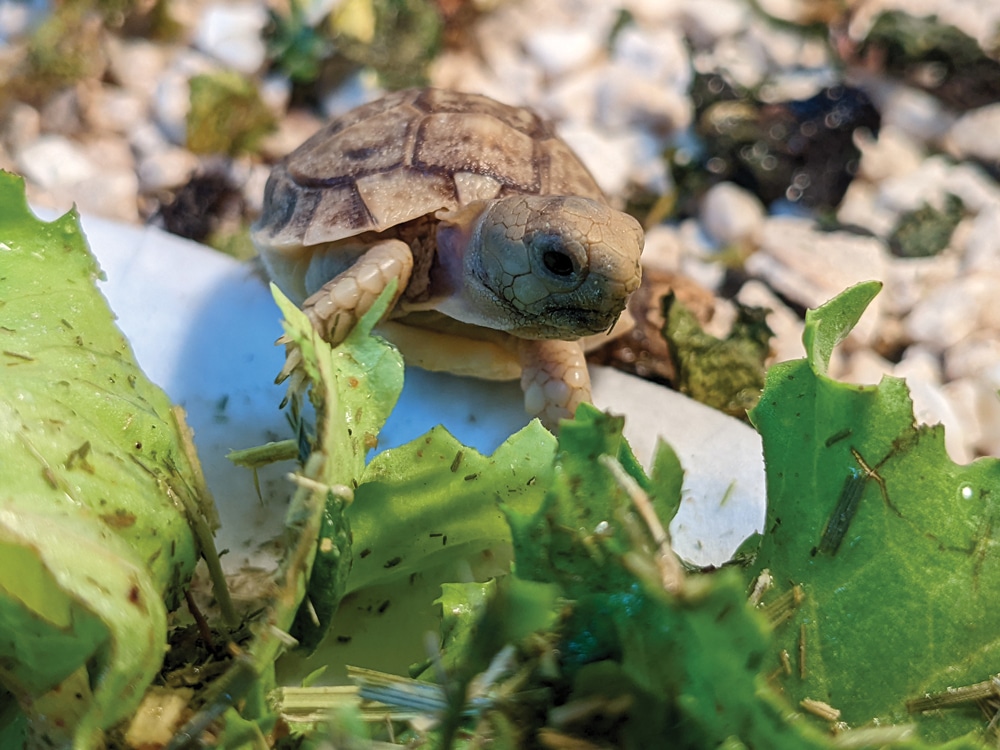
The tortoises should be fed daily with a diet of greens with a high calcium to phosphorus ratio.
Supplementation
We utilize multiple vitamins and calcium, the latter with D3, since our tortoises do not get natural sunlight. Zoo Med’s Reptivite and Rep-Cal’s calcium are the two products we trust the most. We simply sprinkle the vitamins and calcium very lightly on the food about one to two times per week. Fresh broken pieces of cuttlebone are lavished, especially by gravid females and also assists in natural trimming of their beak. Cuttlebone does not need to be the product marketed for turtles, and can be those sold for bird keeping, or purchased in bulk online much more affordably.
Substrate
This is the most widely contested subject in the keeping of Egyptian tortoises, particularly between leading keepers in the United States and those in Europe. Crushed coral is a popular substrate with which US-based keepers and has been used with great success. We prefer either crushed coral, an aragonite-based sand for babies and often a mix of the two. If you wish to use crushed coral in your substrate mixtures, it is available in pet stores or especially in feed and grain stores since it is most commonly used for chickens. The aragonite-based sands are sold under various brand names and are made of calcium carbonate.
The key here is to provide a substrate that creates an environment where the substrate is usually dry to the touch, but where humidity below the surface can be trapped and held for a time, and where impaction from accidental ingestion of the substrate is not likely. Egyptian tortoises are a coastal species, so a bit of misting in the morning can be helpful. A humid hide can be provided with a plastic plant pot cut in half or fashioned with a cutout large enough for the tortoise to pass through. Providing a substrate that is more diggable and that can retain a bit of moisture under hides and in nesting areas is important for growing tortoises and nesting females, respectively.
Enclosures
We utilize pens and enclosures made out of various materials. We build our own enclosures of either wood or expanded PVC. The latter can work well when the animals are misted and when water dishes are flipped over. Concrete mixing tubs and other plastic tubs can work well for housing Egyptian tortoises. The minimum size for one or two hatchlings should be 12 x 24-inches. This will suffice for the first year after which you’ll need to provide much more space.
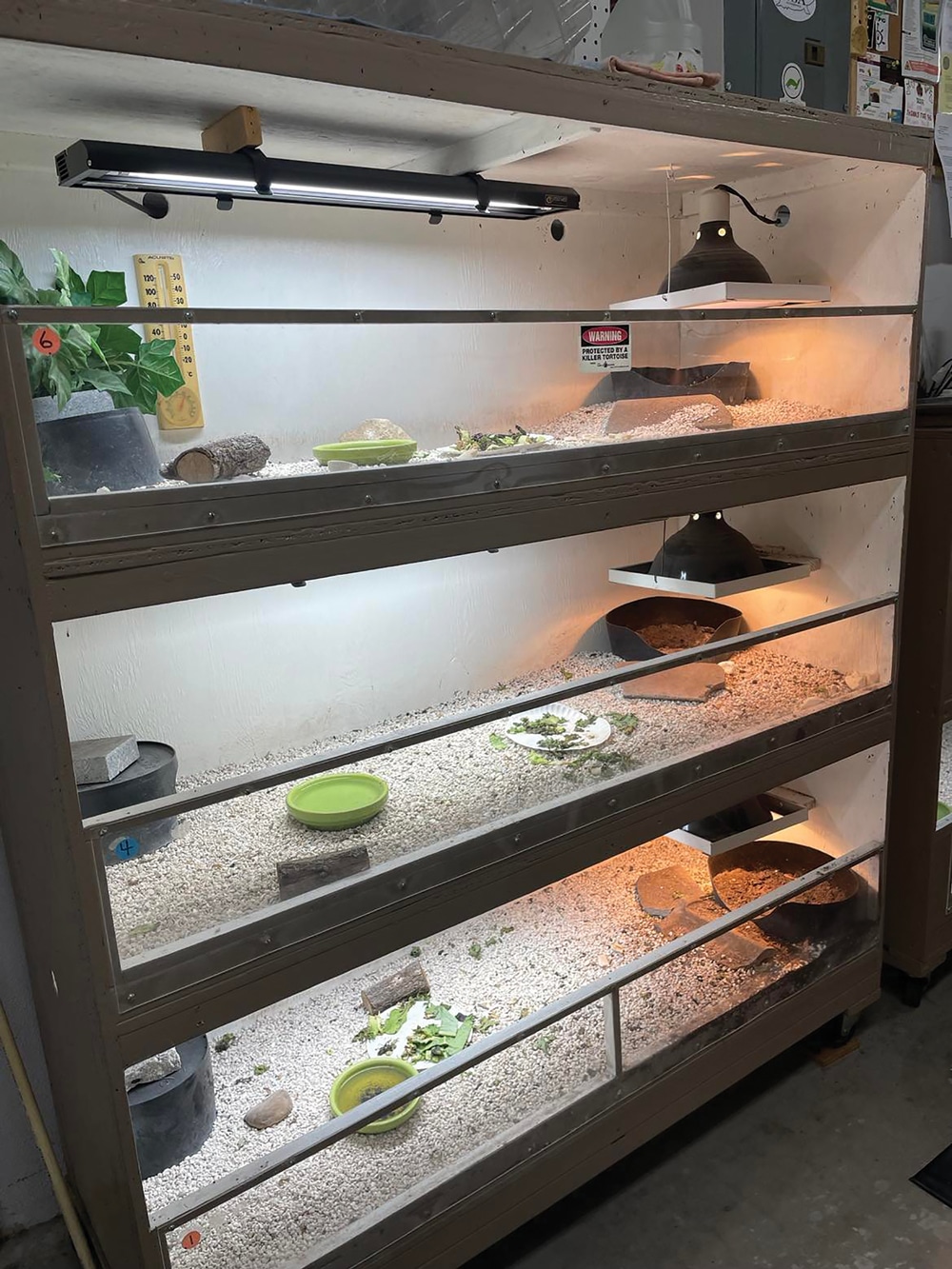
The Egyptian tortoise enclosure is quite large despite their diminutive size.
At minimum, a 36 x 18-inch enclosure with proper ventilation should be used. Bigger is always better. Avoid glass aquariums, as they do not allow for any ventilation and the glass walls can confuse and stress animals, making them feel like they are in a wide open space, held by walls they cannot see but that they also cannot walk through.
Temperatures
Egyptian tortoises seem to prefer temperatures between about 75 to 80 degrees Fahrenheit (23.9 to 26.7 degrees Celsius), but will be okay as long as the temperature does not drop below 60 degrees Fahrenheit (15.6 degrees Celsius) at night. The nightly cool down is especially safe if a daily warming to at least 75 to 80°F is the norm. The pen should have a warm end with a hot spot of about 90 to 100 degrees Fahrenheit (32.2 to 37.8 degrees Celsius). The opposite end of the pen should provide a cooler retreat from the heat of the basking lamp, where temperatures range between 68 to 80 degrees Fahrenheit (20 to 26.7 degrees Celsius) during the day.
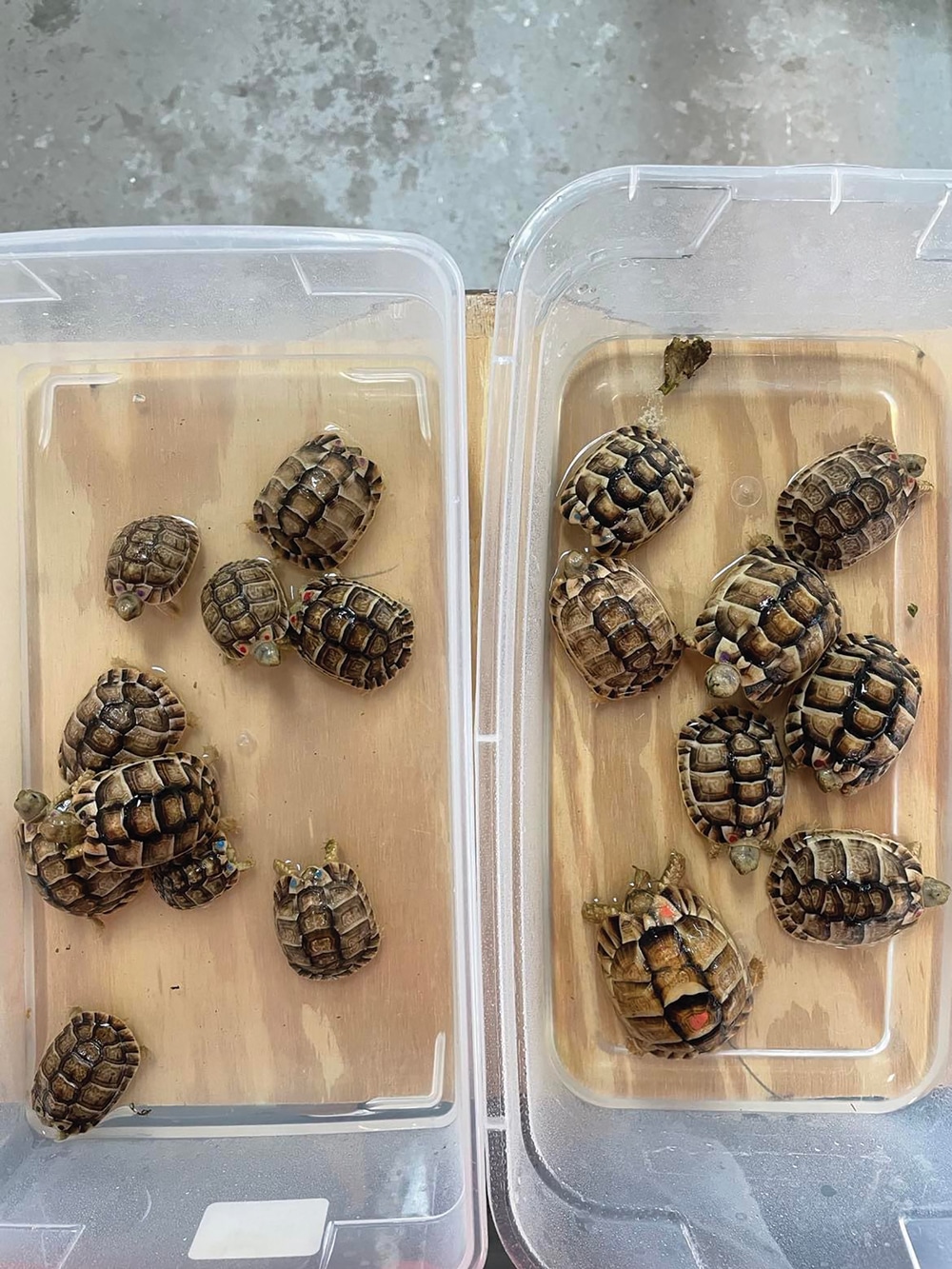
Hatchlings getting a soak.
The heat can be provided by a regular light incandescent bulb, although these have been more difficult to find as society appropriately pushes for the use of more energy efficient light bulbs for our homes. Experimentation with different size bulbs can help us ensure the proper temperatures are achieved. Ceramic heaters and radiant heat panels can be used to provide the heat needed around the basking spot. The use of thermostats can help protect against unsafe temperatures regardless of what is used to provide the heat.
It is imperative when designing enclosures that caution is taken to ensure the little Egyptian tortoise can easily escape the hot area of the enclosure and cool down when desired. Be sure not to guess on temperatures and purchase a temp gun. We feel this is well worth the investment.
Lighting
We use a few different protocols for lighting with Egyptian tortoises. Most often, Reptisun T5-5.0 or T8-10.0 fluorescent bulbs and appropriate fixtures are hung roughly 12 to 14 inches above the substrate. Mercury vapor bulbs can also be used and provide both heat and UVB in one bulb. While lighting can be expensive, it is important to invest in the health of your tortoises by providing adequate light supplementation.
While expensive, we also recommend a Solarmeter to accurately measure UVB output, as this can vary much more than one might guess. This also allows for monitoring when bulbs need to be replaced. The use of timers can be helpful for providing a seasonal cycle for these tortoises, who display significant seasonality in the behavior.
Hides
Egyptian tortoises, especially hatchlings, are quite susceptible to stress and they love to hide. It is important to remember that these are prey animals and that wide open areas will produce stress, which is a common causation for significant health concerns. For this reason, hides are imperative.
For young animals, hides can be large enough to accommodate all the babies in one, but having a few scattered around the pens allows the tortoises to get away from other tortoises if they prefer. Providing multiple hides also ensures animals can select a hide box with the temperature they prefer or need at a given time. They may move to different hides at different times of the day, or on different days.
Humidity
It is of utmost importance to soak the babies almost daily. Less frequent but still consistent soaks should be provided to adults, as well. This should be done with water that is between about 85 to 90 degrees Fahrenheit (29.4 to 32.2 degrees Celsius). Enclosures are also sprayed in the morning. Their pens should not remain damp past about noontime, so that the tortoises definitely are dry overnight. Shallow dishes for fresh drinking water should always be present.
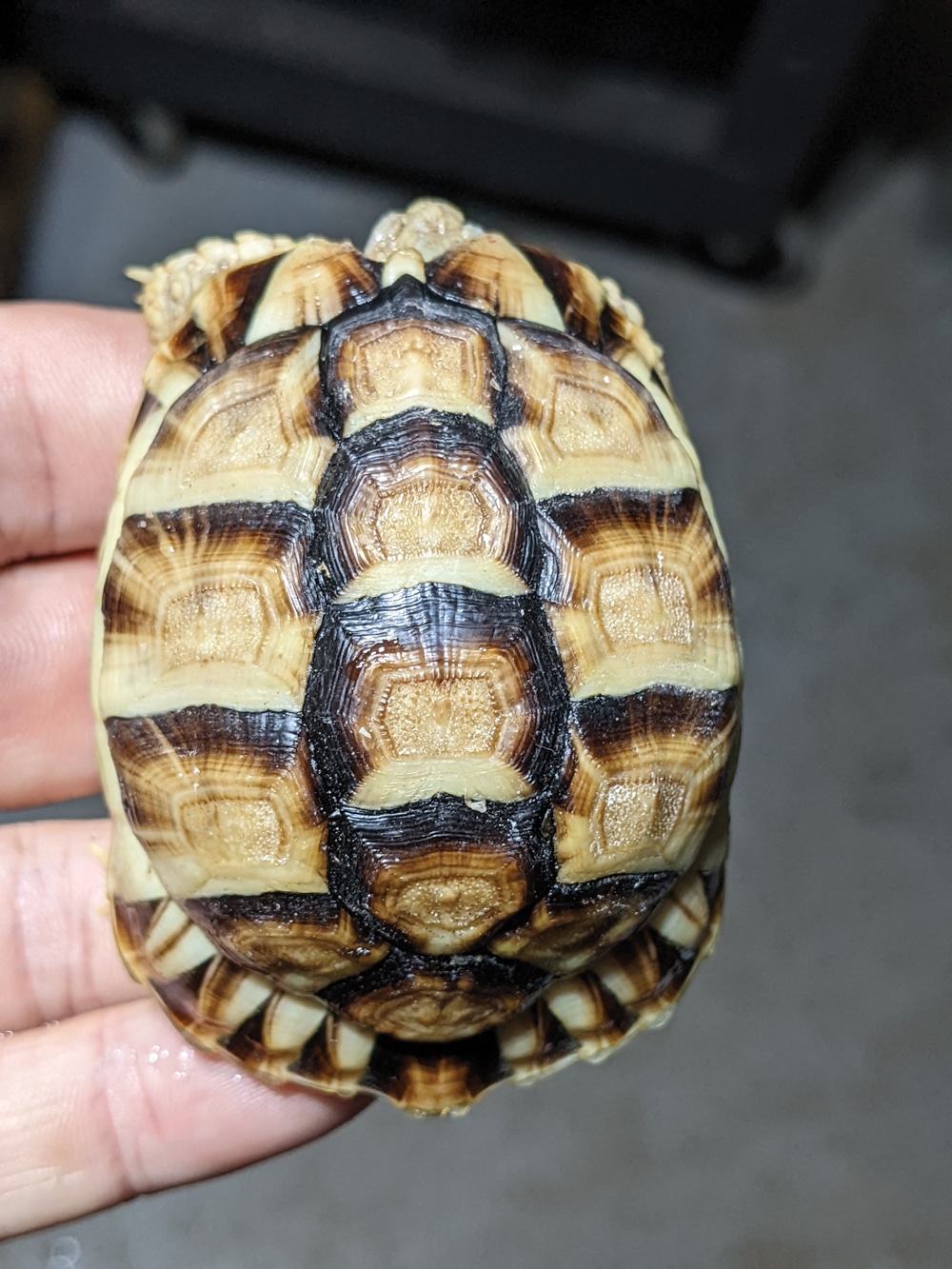
Breeding
As with any species that is critically endangered and at imminent risk of becoming functionally extinct in the wild, Egyptian tortoises should be bred in captivity if at all possible. At this point, several species have been saved from true extinction, much thanks to breeding by the private sector, like McCord’s box turtle, Cuora mccordi, the yellow-headed box turtle, Cuora aurocapitata, Vietnamese pond turtle, Mauremys annamensis, red-necked pond turtle, Mauremys nigricans, and the Burmese star tortoise, Geochelone platynota.
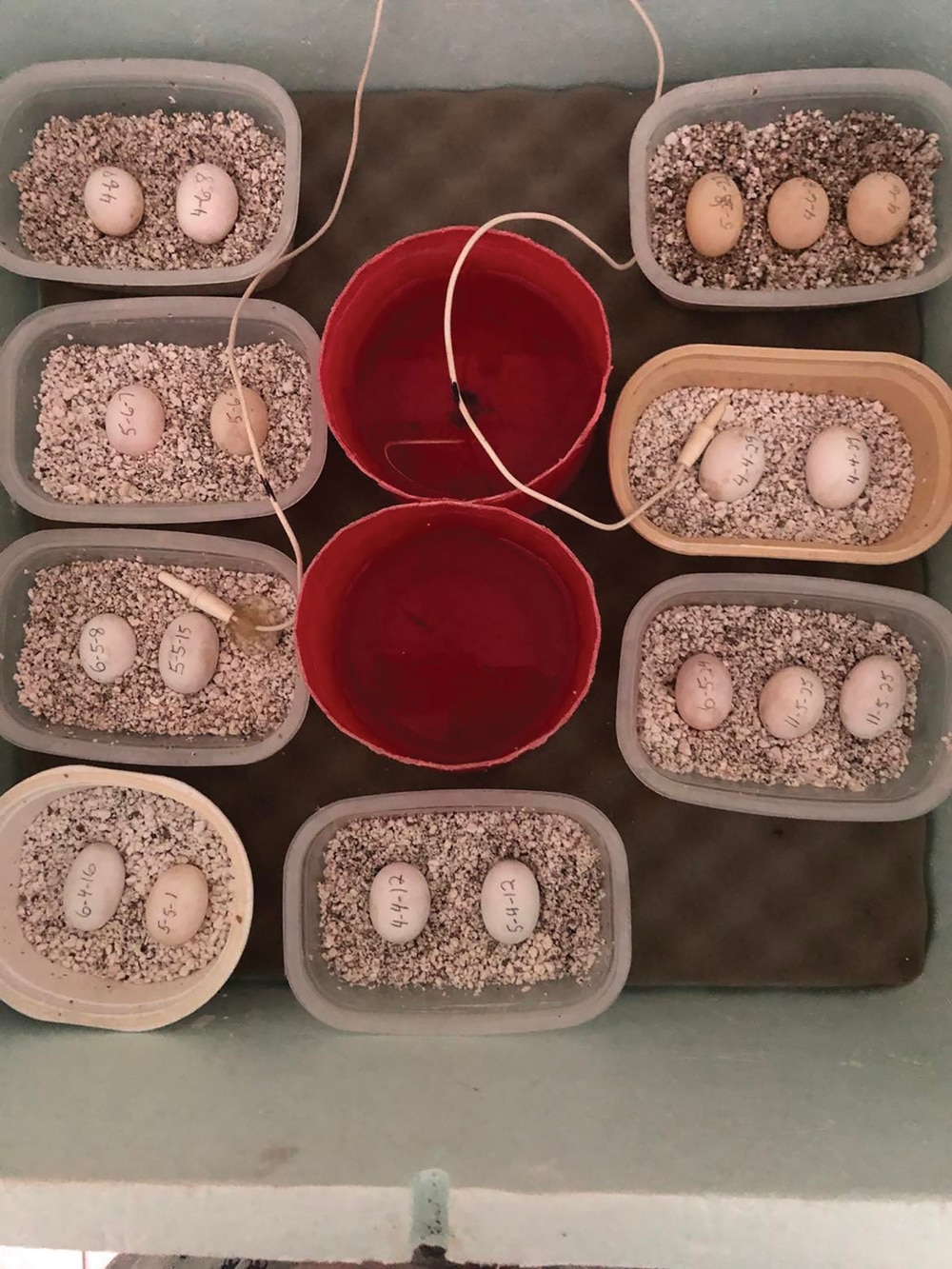
Egyptian tortoise eggs
In order for successful reproduction to take place with the Egyptian tortoise, supervised male to male combat is suggested. The presence of other males helps to increase the drive to procreate in one another. We keep adults separately and only introduce them for combat and breeding. When males have had the chance to joust with one another, they are ready to be introduced to mature females.Young females are not placed with males until they have reached more than 300 grams. If females that are too small are bred, the risk of dystocia becomes more probable.
Captive Success
A handful of dedicated breeders in the United States have worked diligently over the last several decades to create stable, well diversified, breeding groups. Only now, after years of nurturing our animals are we starting to see impactful results. The Egyptian tortoise is slow to mature – attaining sexual maturity around 8 to 10 years of age. The fecundity of the species is also quite low, as with other small chelonians. Even in a great year, they generally produce less than 10 eggs throughout a season.
The Angulate Tortoise Of South Africa
Hermann’s Tortoise Care And Information
Yet we persevere, not for monetary gain, but for the passion of knowing that we are contributing where their native country has failed to protect the species. This is the preservation of an endangered species. We are doing our part to make sure the species is never smuggled into our country again, and it is working. Far more captive bred Egyptian tortoises are available than ever before. If anything, the proposed ESA listing of the Egyptian tortoise has only driven up the demand for the species – something we hope we can continue to overcome.
The largest piece worth considering here is the propagation of captive-bred endangered specimens in the United States each year. Our partner, the Turtle and Tortoise Preservation Group (TTPG) works hard to maintain a network of turtle keepers who work together to maintain diverse populations of captive-bred animals. In collaboration with their team, we have compiled numbers for captive-produced Egyptian tortoises in the United States. Over the past three years, 503 hatchlings have been produced in 11 states, by 16 dedicated and talented breeders. Their recent success has led to genetically diverse representation of this species being distributed legally to other turtle keepers around the country.
Conclusion
The collective missions of our organizations include the conservation and preservation of endangered turtles and tortoises in a variety of ways, through in-situ, ex-situ and especially educational programs. If our work has taught us anything, it is that conservation is complicated and multifaceted. We know how difficult the job of this committee and of the wildlife officials who protect wildlife is and we applaud them on the work that they do. We are proud stewards for conservation and we support the use of laws that protect species. With that said, this particular proposal brings a particular concern that is unique to this situation.
The first item to take into account is the flawed nature of listing exotic species on the ESA. This is especially true, given that over the last few years, the US Fish and Wildlife Service (USFWS) has stopped granting Captive Bred Wildlife (CBW) permits to legal breeders and preservation-minded private keepers of ESA species. In fact, the listing of nonnative species under the ESA is not just redundant and pointless, it is actually harmful to conservation efforts for nonnative species, as it prevents individuals from sharing animals to increase genetic diversity.
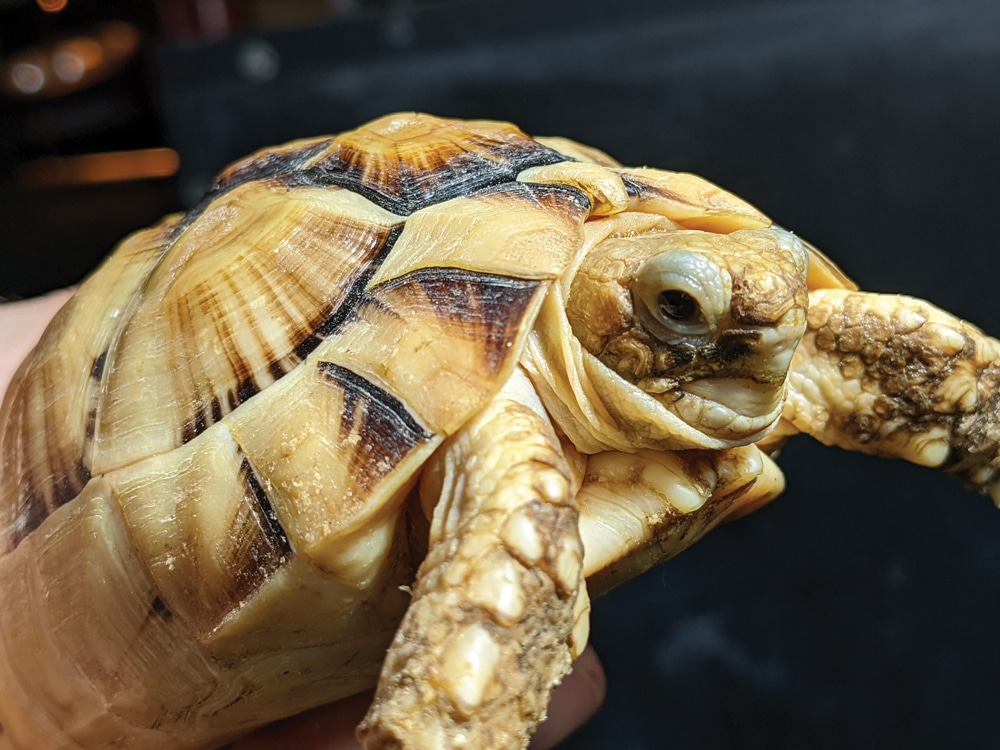
It has been proven that a single private breeder can produce far more offspring every year than all of the zoos in America combined.
For decades now, CITES has been the global organization governing international trade and movement of endangered and threatened species. CITES is now an incredibly robust worldwide society with nearly 200 member countries. CITES has actually helped to create a situation, in addition to captive breeding, where Egyptian tortoises are no longer imported or smuggled into the United States. This is a huge win.
Long gone are the days of heavy importation and large-scale mortality of this species in captivity – a true triumph on behalf of this important species. This proposed legislation would directly affect the success that has been gained over three or four decades. The private sector’s production of healthy, captive-hatched, endangered species far surpasses what the zoos and aquariums in this country have been able to provide.
It has been proven that a single private breeder can produce far more offspring every year than all of the zoos in America combined. We love our friends and partners at zoological institutions around the country, but they cannot breed every species. While we understand that Egyptian tortoises are not bringing visitors through the turnstiles at zoos everywhere, the species does need to be preserved.
Several years ago, a well-received article on Egyptian tortoises for a leading industry journal ended with a call to action. As with most private keepers in the US, great pride in the care of the animals in our charges must be taken. Sadly, we are their only hope for a future on this Earth, so it is imperative that all efforts are taken to not only preserve, but to ensure that rare, productive breeding colonies are established and maintained for the betterment of the species.
Anthony Pierlioni is the vice president of theTurtleRoom, an international turtle conservation organization. He also works in veterinary leadership and regional training. Anthony keeps and breeds numerous endangered turtle and tortoise species and works to educate the public about their plight. He has written books on the leaf turtles and on Veterinary Leadership. Anthony is also the host of the “Pondcast,” the world’s first turtle podcast, and “Turtley Devoted,” a show about turtles, the people who love them, and the people who love them. Follow him on Instagram and Facebook.
Ralph Till is the president of the Tampa Bay Turtle and Tortoise Society, a Florida-based organization that aims to make the world a better place for turtles through education and collaboration. Ralph has been keeping and breeding chelonians for years, specializing in Egyptian tortoises, Testudo kleinmanni, and spider tortoises, Pyxis ssp. He has written for numerous publications in several languages and is seen as an industry leader in having a focused collection plan that involves becoming an expert in a very small number of species.

